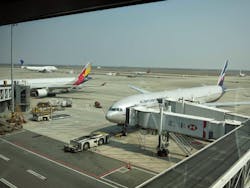China’s Big Hopes for Development
China plans to continue active development of its domestic ground handling industry in the next decade, which will take place through further de-monopolization and technical modernization, according to recent statements of some senior officials of the Chinese Ministry of Transport and leading local ground service providers.
Despite economic stagnation, which has been observed in the Chinese economy in recent years, the country currently remains the world’s second largest and one of the world’s fastest growing civil aviation markets, with plans to maintain this status for years to come.
At present, China has 218 civil aviation airports, including the world’s second busiest in Beijing and plans to increase the number of domestic airports to 260 by 2020. This will allow the country to implement its ambitious goals and to increase passenger traffic by 1½ to 2 times within the next decade, compared to the current figures.
However, implementation of these plans will mainly depend on the ability of the Chinese government to solve some of the major problems of its aviation industry, along with problems of related sectors, such as ground handling.
In contrast to the system of air traffic control, where in recent years significant improvements have been made (mainly in the form of its massive technical re-equipment), the current situation with ground handling at the majority of Chinese airports remains complex.
Despite lower oil prices, a number of problems still prevent a rapid growth. Among them are ever-rising labor costs and growth of low-cost airlines’ market share. This has led to lower profits for Chinese ground service providers.
Perhaps the most important problem of the industry is associated with the lack of competition within it, which is restricted by existing monopolies. This problem remains pressing, despite the fact some progress has been achieved in recent years.
Lately, many operators of China’s airports have tried to create conditions to increase competition, however, despite their efforts, the competition level remains low, which is also due to over-regulation of the industry by the state.
This is confirmed by recent statements of some global ground handlers, operating in China who said excessive state regulation of the industry currently remains one of its major problems. According to multiple ground handling firms, this prevents their expansion at the biggest airports of the country.
The same position is shared by some independent Chinese experts in the field of ground handling.
Yang Xiuyun, a senior expert from the Xiamen University in the field of aviation and ground handling, says despite the efforts, which have been made by the state for the liberalization of the domestic industry of ground handling in recent years, access for operators is still associated with strict entry requirements and barriers.
He also adds this significantly complicates the attraction of investments to the industry (including foreign), that could be used for the development of its infrastructure.In the meantime, the Chinese airport authorities, from their side, have repeatedly denied these allegations. According to them, the government started deregulation of the airport industry and ground handling sector as far back as the 1980s. Its main objective at that period was to boost its development to reduce the government’s burden on it. Airports have been given relative freedom to set prices within price caps, thus promoting the maximization of profits and efficiency.
Anyway, the problem still exists, as is the case of the majority of emerging nations. Monopolistic structures in the Chinese airports are represented by a monopoly of an independent ground handling provider, a monopoly of an airline and a monopoly of an airport as well.
Chinese analysts in the field say a lack of competition in the industry is mainly reflected by a limited number of ground handlers operating in Chinese airports and the existing barriers for the access of new providers. This leads to higher prices and provides an opportunity to monopolists to dictate their conditions to airlines and other market participants.
An example of this is a recent decision of Hong Kong International Airport to introduce a charge for putting luggage onto the carousel. According to analysts’ assessments, this move could cost passenger airlines HK$40 million ($5.1 million USD) or more a year.
In order to raise its revenue, last year, the airport already launched what it called a new speedier security screening process, with airlines paying HK$20 per passenger.
In fact, the airport has raised plane parking and landing fees by 27 percent spread over three years since September 2016, linked to funding its HK$141.5 billion expansion, including its third runway.
Surprisingly, but, according to results of a recent study, dedicated to the level of competition in the Chinese airports, conducted by the experts of the Ministries of Economy and Transport of China, the Hong Kong International Airport is currently the only airport in China, where the number of ground handlers has doubled in recent years.
At the same time, in the majority of other Chinese airports the number of ground handlers operating rarely exceeds one or two companies.
Due to existing monopolies, the biggest ground services groups have had a relatively limited presence in China so far. However many of them still consider the Chinese market as very promising for their further growth, hoping that planned de-monopolization of the industry will provide them better access to the market.
In the meantime, the Chinese airport authorities are aware of the current problems in the industry, and are considering adopting measures for their solution.
According to some reports by Chinese media and sources in the local government, part of these plans are setting a limit for the number of ground handling providers, operating at local airports, tightening control over the costs charged by local ground handlers, as well as better training of the industry’s personnel.
In the case of personnel, according to predictions of some Chinese analysts, the ever-growing traffic at local airports will contribute to further demand for skilled ground handling personnel.
Currently labor accounts for 65-80 percent of the costs in the industry. In recent years, the industry has been faced with a significant worker turnover and wage pressure. In addition, the number of skilled workers remains limited.
Due to this, the Chinese airport authorities together with leading local ground handlers and airports plans to tighten a control for the training of personnel and to provide additional benefits to the industry’s employees.
That plan involves a significant raise of the quality of staff, which will also take place through the attraction of specialists from abroad, as was the case for pilots.
For this purpose, the Chinese airport authorities, together with local ground handlers, are even considering introducing a system of seasonal employment in the industry.
“The shortage of aviation personnel is currently observed in global scale. However, in the Asia-Pacific region, particularly China, this issue is even more acute than in other regions of the world,” says Bob Belitto, director of international sales for Boeing Flight Services.
“Due to this shortage, airlines and ground handling operators must find solutions to this problem and to supply the aviation ground handling industry with the necessary number of technical staff in the future,” he adds.
Still, despite the existing problems, leading local ground handlers plan to continue their development in years to come. According to them, this will mostly take place through the active introduction of technological innovations in their ground handling operations, speeding handling process in their day-to-day operations, particularly baggage screening, sorting and tracking. The hope is more active use of technology will improve passenger experience and boost the overall growth of the Chinese ground handling market.
About the Author

Eugene Gerden
Eugene Gerden is an international freelance writer, who specializes in covering the global aviation and ground handling industries. He has worked for several industry titles and can be reached at [email protected].
